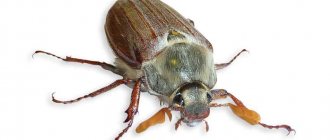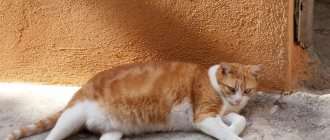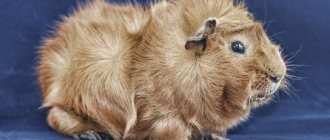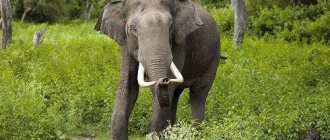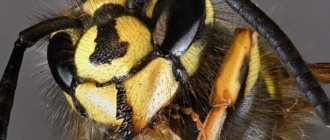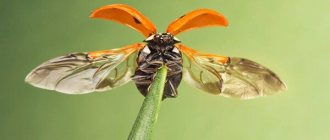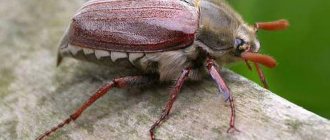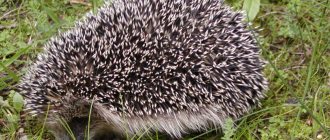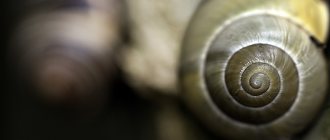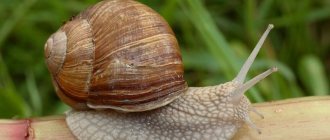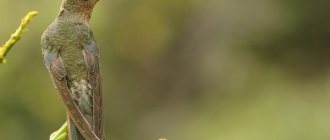Coleoptera is one of the most numerous orders of insects, which includes over 400 thousand species. Among them are the well-known ladybugs, May and Colorado beetles, ground beetles, rhinoceros beetles, weevils, and many others. Despite their significant differences in appearance, all beetles have a number of identical characteristic features and characteristics. It is worth noting that about 13.5 thousand species live in Russia. Among them are pests that cause damage to agriculture. However, there are also those that are beneficial. For example, farmers use ladybugs, rove beetles, blister beetles, marigolds and other predatory insects as a safe biological way to control many pests.
Hungarian ground beetle
Signs of Coleoptera insects
Coleoptera have a body divided into three main segments:
- head;
- breast;
- abdomen.
Two pairs of wings are attached to the thoracic section of the body, which have a relatively high hardness (it is in honor of this that the order received its name - this is the main distinguishing feature of beetles from other representatives of the insect class).
The head basically has a head capsule to which the oral appendages and antennae are attached. In the proximal part of the head there is an oral apparatus. Also in this section of the body of beetles there are organs of external sensitivity: smell, vision and touch. The antennae are organs of touch. The eyes have a facet structure. The oral apparatus is of the gnawing type; it is necessary for grinding solid food during the life of beetles.
The chest is divided into three segments: proximal, median, distal. Wings and limbs are attached to the chest (the pelvic cavities are the attachment point for walking limbs). Walking limbs have a typical structure.
The abdomen is the wide distal end of the body of representatives of the order Coleoptera. It contains most of the internal organs (for example, protonephridia). Part of the walking limbs is also attached to the abdomen. In most representatives of the order Coleoptera, this part of the body occupies about half of the body area. The internal structure of beetles is typical of that of representatives of the class of insects.
Separately, it should be noted that these insects are able to perfectly camouflage themselves in various environmental objects due to a special type of coloring. This increases their ability to survive, moving this unit up the evolutionary ladder.
What insects are Coleoptera?
The general name of coleopteran insects is beetles. The reason for this name is the buzzing sounds made by these creatures. Beetles are considered eurybionts - creatures that have adapted to life in various natural conditions. Indeed, beetles can be found in every corner of the planet, with the exception of the cold Arctic, Antarctica and the highest mountain peaks. But beetles feel best in warm climate zones, so a greater variety of beetles is observed in tropical forests.
The Coleoptera order includes 6 main families, whose representatives make up more than half of the total diversity of these insects:
- carnivorous beetles;
- ground beetles;
- weevils;
- leaf beetles;
- lamellar;
- barbel
Representatives of Coleoptera differ in body size.
In some species, adult individuals barely grow to 0.3 mm in length (featherwing beetles), while other representatives are real giants in the world of insects - their body length can reach 17 cm (titanium woodcutter beetle). All beetles have the same body structure. The main features of Coleoptera:
- strong compact body;
- hard integument, leathery or sclerotized elytra;
- membranous wings with which beetles fly. At rest, a pair of wings is hidden under the elytra;
- the oral apparatus is predominantly of the gnawing type.
Type of development
Most representatives of Coleoptera are dioecious animals. There is pronounced sexual dimorphism (in some species, males are much larger than females, sometimes the situation is the opposite; in any case, it is quite easy to distinguish males from females in representatives of this order). The life cycle of beetles has a number of successive stages:
- egg;
- larva;
- chrysalis;
- imago.
This sequence of stages during the development of an insect is called a life cycle with complete metamorphosis.
Lifestyle and nutritional habits
Beetle insects occupy different niches in different ecosystems. Coleoptera lead an active lifestyle, constantly searching for food.
Most beetles are either phytophages (vegetarian insects) or predators. In addition, saprophages (feed on rotting carcasses), coprophages (feed on animal excrement) and necrophages (scavengers) are common. Some beetles store food in burrows to survive in times of famine. Coleoptera are known that do not feed at all in the imago stage, since they have enough nutrients stored in the larval stage.
Among beetles, there are several species that lead a parasitic way of life. For example, representatives of rove beetles of the genus Akochara parasitize on fly pupae, some ground beetles parasitize on leaf beetle larvae, and blister beetles sneak into bee nests, destroying almost all the eggs and larvae there.
Power types
Coleoptera, like almost all eukaryotes, are heteroorganotrophs. Beetles feed mainly on plant foods, with the exception of representatives of the order Coleoptera, which use fungal mycelium (mycelophages) as food. In addition to mycelophages, the following groups of beetles are distinguished based on the food they consume as an energy source:
- phytophages (leaves);
- anthophages (pollen and flowers);
- carpophagous (seeds).
There are also saprophytic beetles that eat decaying plant remains.
What do beetles eat?
Some insects, such as mosquitoes, lice and bedbugs, feed on blood. Others eat smaller insects and act as predators in the food chain. Some feed on droppings or dead animal carcasses.
On the other hand, there are certain herbivorous insects such as beetles. So, if you've ever thought that bugs are more likely to chew and eat hard objects, you're right. Their favorite foods include leaves, wood and fruits.
But not all beetles eat only plants. Some of them are omnivores. Although, certain species only eat specific plants and nothing else! Good examples of this are the red-breasted owls, which only consume grain crops.
Carnivorous beetles often eat snails, earthworms and other living creatures. On the other hand, there are some beetles that eat excrement. They are called coprophages (for example, dung beetles). Necrophages are beetles that participate in the decomposition of organisms and eat dead carcasses (for example, carrion eaters).
Where live
Bugs live everywhere. There are even known representatives that live under water. There is a streamlined body. They inhabit deserts and tropical forests. They live in the upper layers of the soil. Occupy different parts of plants. Beetles are able to settle in mushrooms and eat them throughout their life cycle.
Scavengers occupy the dead bodies of animals. Dung beetles are found in fecal matter. This is the basis of insect nutrition. Aquatic insects occupy fresh water bodies, less often salty ones. Some of the species are able to live both on land and under water.
Insects live in human homes or outbuildings. Capable of destroying food supplies or wooden furniture elements. Needs destruction. The bugs bite painfully.
Harmful and beneficial bugs
The concept of harm and benefit was introduced by people. In relation to them, beetles can be roughly divided. For nature, all living beings are equally valuable and have their role.
When the vital activity of beetles comes into contact with humans, then concepts of benefit and harm arise.
Harmful bugs
This conditional group includes beetles whose activities harm plants. Some beetles are polyphagous animals that destroy plants of different families. These include:
- polyphagous Colorado potato beetle;
- the click beetle, and especially its larva – the wireworm;
Chafer.
- a mole cricket whose activity destroys everything in its path;
- bread ground beetle;
- species of bark beetles;
- some barbels.
Beneficial Bugs
Ground beetle.
These are coleopterans that help fight insect pests. A sufficient number of them on the site helps balance the number of insects. These are:
- ladybugs;
- some ground beetles;
- soft fireman;
- ant motley.
Life cycle
Larva Material from the site https://doklad-referat.ru
Among beetle larvae, there are two main types: open-living, very mobile, usually predatory forms, with well-developed running or swimming legs; secretively living, sedentary, more or less worm-like forms, with poorly developed legs or without them - this group is dominated by soil dwellers or consumers of wood or mushrooms.
Development
The development of beetles proceeds with complete transformation - a pupa is formed.
On this page there is material on the following topics:
Beetles or Coleoptera - general characteristics, habitat, reproduction
Detachment Coleoptera report
Beetles general structure briefly
Beetles structure briefly
Coleoptera summary is very brief
Questions about this material:
What are the development features
Between the egg stage and the mature individual there is a larval stage. This developmental feature is characteristic only of insects. General features of caterpillars:
- voluminous head with powerful mouthparts;
- elongated body;
- limbs are absent or poorly developed.
The appearance of the larvae directly depends on the area of residence. Transformation into an adult occurs after pupation.
Interspecific crossing among beetles is quite common. This is not uncommon. Development may be disrupted. This results in the birth of beetles with characteristics of both females and males.
All beetles go through a larval stage
How beetles take care of their offspring
Coleoptera are distinguished by increased care for their offspring. This is expressed in the preparation of food for the larva for the first time. Some subspecies even groom the new generation before the egg hatches.
Beetles reproduce by laying eggs
Females lay eggs only in safe places, namely in specially constructed shelters. Also, for example, leaf beetles build dense covers for eggs. The protective capsule consists of insect feces.
It is interesting to know that, for example, dung beetles prepare food and build shelter for their offspring in pairs. Not only the male, but also the female takes part in this activity.
Where does it live?
The leaf beetle is considered the most common and at the same time the most widespread species of beetles in principle, which is why the family does not have a specific habitat, because many thousands of species live throughout the entire globe, with the exception of Antarctica and the areas closest to it. In the CIS alone, scientists count about three thousand species, and in Siberia alone their number reaches five hundred. All these factors indicate that leaf beetles are distributed throughout the world and it is simply impossible to name any exact boundaries, because all this would be a vague lie.
Appearance
Due to the huge number of species, external signs for each can be completely different, some of them are not similar to others not only in color, size and some distinctive features, but also in structure, place and way of life, as well as in the variety of other signs. In principle, describing a full-fledged family in general terms is not the most practical. But if you choose, you can average some indicators and collect a list of factors that coincide to one degree or another in most species.
The body shape of leaf beetles is mostly oval or round, but can also be elongated or flattened. The sizes are completely different, but generally they vary from three to four millimeters to two centimeters. All members of the family have hard elytra that more closely resemble carapace or armor, and there are many spike-like outgrowths throughout the body. They are used for protection, and also give external massiveness, thanks to which the insect repels ill-wishers.
Basically, insects of this family have multi-colored colors, which can consist not only of bright and vibrant colors, but also of very dull, monotonous ones. A feature of these insects can also be called a skill, thanks to which they can hide their legs and antennae under their body, like snails or turtles that hide in their armor for protection. This gives the impression that the beetle has no limbs at all.
The wings are very well developed, since the animal often has to fly long distances. They show a large number of longitudinal veins, and the edges are often curved down. The insect's chest is always smaller than its back, which makes it seem as if the beetle has a hump. Females are slightly larger than males in size.
Do beetles differ depending on gender?
Sexual dimorphism is strong among different beetle species. Males are smaller. Females are more powerful. They live longer. Males with a narrowed body. Males with powerful and widened paws. This is necessary to capture the female during mating. There are pronounced mandibles.
In this video you will find a lot of interesting things about giant beetles:
Gender can be manifested by the shape and color of the pronotum. Males have larger mustaches than females. Females are less mobile. Poorly developed wings or no wings are often observed.
External structure
These insects are called Coleoptera because they have dense, hard wings of the front pair - the so-called elytra, which cover, like a lid, the thin, transparent wings of the rear pair and the abdomen (Fig. 96). Another common feature shared by all beetles is their gnawing mouthparts.
The antennae of representatives of different families are very diverse: thread-like, lamellar, club-shaped, comb-shaped - beetles are often identified using them.
The sizes of beetles range from 0.2 to 200 mm.
What is the internal structure
The internal structure is almost the same as that of other insects. The body cavity is mixed. There are two longitudinal membranes. The digestive system has three sections:
- front;
- rear;
- average.
The circulatory system is reduced. A dorsal vessel is present. The pharynx and esophagus are used for swallowing food. The heart consists of successive chambers.
Beetles have well-developed sense organs. The eyes are compound. Some of the representatives have poorly developed visual organs or live without them.
Order Coleoptera, or Beetles (Coleoptera)
May beetles. The beauty is fragrant. Banded swimmer
They have two pairs of wings, the front pair of wings turns into hard, veinless elytra (elytra), which at rest cover the hind membranous wings. The mouthparts are gnawing type. The eyes are only compound. Development with complete transformation, including 4 phases: egg → larva → pupa → imago. In representatives of some families, development goes through a greater number of phases, such development is called hypermetamorphosis (blisters).
rice. 1. Scented beetle (Calasoma sycophanta)
The order Coleoptera is divided into suborders: 1) Carnivorous beetles (Adephaga), 2) Herbivorous beetles (Polyphaga), 3) Ancient beetles (Archostemata). The predominant number of beetle species belongs to the first two suborders.
The suborder Carnivorous beetles is divided into families: ground beetles (Carabidae), diving beetles (Dytiscidae), spinning beetles (Gyrinidae), etc.
The fragrant beetle (Calasoma sycophanta) belongs to the ground beetle family. Lives in forests and gardens. Runs and flies well. Unlike other species of ground beetles, it is active during the day. Both adult beetles and larvae are very voracious; they often climb trees, where they hunt caterpillars and other insects (Fig. 1). They pupate in the soil. Adults live 2–3 years; they also bury themselves in the soil for the winter.
The odorous beetle is listed in the Red Book of Russia as a species with rapidly declining numbers. Beauty beetles are regulators of the number of pests in gardening and forestry.
rice. 2. Margined swimmer (Dytiscus marginalis): A - male, B - female, C - larva.
The fringed swimmer (Dytiscus marginalis) belongs to the family Diving. (Fig. 2). Lives in calm waters rich in vegetation. Body length 3–3.5 cm. The third pair of legs is swimming. During the day they remain in shelter, from time to time rising to the surface of the water to breathe air. At the same time, the end of the abdomen is protruded from the water and the tracheal system is filled with a new portion of fresh air. At night they hunt small animals; their prey is not only all kinds of aquatic invertebrates, but also tadpoles, frogs, and fish fry. They can fly from one body of water to another. The female lays eggs in aquatic plants with her ovipositor. The larvae of diving beetles are predators. Their saber-shaped mandibles have a channel inside through which the larva sucks out its prey. The larva pupates on the shore, burrowing into the ground.
The suborder Multivorous beetles is divided into the families Water lovers (Hydrophilidae), Lamellar beetles (Scarabaeidae), Click beetles (Elateridae), Ladybugs (Coccinellidae), Weevils (Curculionidae), Bark beetles (Ipidae), Longhorn beetles (Cerambicidae), etc.
rice. 3. Western cockchafer (Melolontha melolontha)
May beetles belong to the Lamellaridae family. In the European part of Russia, two types of cockchafers are found: the western cockchafer (Melolontha melolontha) and the eastern cockchafer (Melolontha hippocastani). The western cockchafer reaches 2.5 cm in length. The apical segment of the abdomen (pygidium) has a long and straight process that does not have an interception. Males have antennae with seven plates, females with six. In the eastern May beetle, the pygidium is intercepted (in males) or very short (in females). The lifestyle of both species is similar. Summer occurs in the spring in May, in the southern regions it is possible in April. The beetles fly around deciduous trees, the leaves of which they feed on; they prefer oak. Flight duration is 20–40 days. To lay eggs, the female burrows into the soil to a depth of 20–30 cm. The female lays about 70 eggs, after which she dies.
After 4–6 weeks, the eggs hatch into larvae that develop underground for several years. The larva is eruciform, has a well-defined head with a gnawing-type mouthparts and three pairs of jointed limbs. The first year the larva feeds on humus, the second on the roots of grasses, the third on the roots of shrubs and trees, which can cause great harm to young tree stands. In the fourth year, at the end of spring, the larva turns into a pupa, and in the fall a young beetle emerges from the pupa and remains to overwinter in the soil. The beetle appears on the soil surface in the spring of next year.
rice. 4. Typograph bark beetle (Ips typographus)
Adult beetles and bark beetle larvae live under the bark of trees, less often in wood. Adults and larvae are herbivorous, gnaw through complex tunnels that are fairly constant in shape for each species. The typograph bark beetle (Ips typographus) inhabits coniferous trees and prefers spruce. Body length reaches 5.5 mm. The apices of the elytra have a depression bordered by four pairs of teeth - a “wheelbarrow”, used for throwing out drilling flour. The larvae are legless, with a hard head.
The passages of its nest are located in the inner layers of the bark, faintly imprinted on the wood. Uterine passages up to 15 cm long extend up and down from the nuptial chamber. Larval passages extend from the uterine passages, ending in pupal “cradles” (Fig. 4). They are usually inhabited by diseased, weakened or cut down trees. The typograph bark beetle is rarely found in healthy plantings.
► Insects with complete metamorphosis (Holometabola) also include the following orders:
- Order Reticulates (Neuroptera)
- Order Hymenoptera (Hymenoptera)
- Order Diptera (Diptera)
- Order Fleas (Siphonaptera, or Aphaniptera)
- Order Lepidoptera, or Butterflies (Lepidoptera)
- Brief description of the class Insects
- Classification of the class Insects
► Go to the table of contents of the book “Zoology of Invertebrates. Theory. Tasks. Answers"
